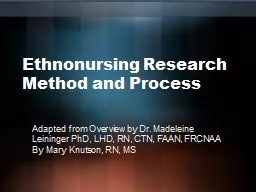

Adapted from Overview by Dr Madeleine Leininger PhD LHD RN CTN FAAN FRCNAA By Mary Knutson RN MS Ethnonursing A qualitative research method as an open discovery process to document describe and understand peoples experiences care meanings and symbols of care ID: 545606
Download Presentation The PPT/PDF document "Ethnonursing Research Method and Process" is the property of its rightful owner. Permission is granted to download and print the materials on this web site for personal, non-commercial use only, and to display it on your personal computer provided you do not modify the materials and that you retain all copyright notices contained in the materials. By downloading content from our website, you accept the terms of this agreement.
Slide1
Ethnonursing Research Method and Process
Adapted from Overview by Dr. Madeleine
Leininger
PhD, LHD, RN, CTN, FAAN, FRCNAA
By Mary Knutson, RN,
MSSlide2
Ethnonursing
A qualitative research method as an open discovery process
to document, describe, and understand people’s experiences, care meanings, and symbols of care
related to their beliefs, values, health, and cultural lifeways
using diverse strategies and enablers.Slide3
Purpose and Process
The Ethnonursing Method was developed by Dr. Leininger in early 1960’s and has been used to study many cultures and subcultures
The method was designed to fit the Culture Care Theory to obtain meaningful dataSlide4
Culture Care Theory
There are more cultural diversities than universalities among and between cultures
Culture care meanings and practices tend to be embedded in the social structure and difficult to find
Cultural context and care values are major difference factors in the way care is expressed, valued, and practicedSlide5
Leininger’s Research Enablers
Over several years, Dr. Leininger developed these unique research enablers to “tease out” data on culture care, health, and wellbeing as well as culture specific practices, and nursing care phenomena.
Sunrise Enabler
Three Phase Observation-Participation-Reflection Enabler
Stranger to Trusted Friend Enabler
Domain of Inquiry Enabler
Acculturation EnablerSlide6
The Sunrise Enabler
Developed in 1970, with subsequent revisions
To discover actual and potential influencers to explain care and wellbeing phenomena from a holistic perspective:
Historical
Cultural/Religious
Economic
Environmental
Other holistic care phenomenaSlide7
Observation-Participation-Reflection Enabler
Phases begin with
Observation and very active listening
Proceed to
Observation with limited participation
Participation with indepth and confirmed observations
Reflection
and
Reconfirmation
of findings with key informantsSlide8
Stranger to Trusted Friend Enabler
Researcher begins as a
Stranger
:
Distrusted by informants
Tested by informants to see response
Informants avoid sharing cultural secrets, stories, or information with researcher
Researcher hopes to become a
Trusted Friend
:
Enters local culture and obtains rich data
Informants share cultural secrets because they want their culture to be understood accuratelySlide9
Domain of Inquiry Enabler
The researcher develops enabler to discover data related to the domain of inquiry (DOI)
First, the DOI needs to be succinctly stated so it can be examined indepth and analyzed
Example:
Exploring culture care of children living in homeless shelter
The researcher determines how to obtain data
Using related interests and “hunches”, research questions are developed to guide the studySlide10
Acculturation Enabler
Assessment of the extent of the informant’s acculturation; are they more traditional or more non-traditional in their cultural values, beliefs, and general lifeways?Slide11
Qualitative Data Analysis
First Phase
Collect
Describe
Document raw data or observation
Use a field journal, recorder, and computer
Second Phase
Identify and categorize descriptors and components of data about domain of inquirySlide12
Data Analysis
Software is recommended to classify and code the data
It can also be done with paper- cutting and pasting the data into patterns and themesSlide13
Qualitative Data Analysis
Third Phase
Identify patterns of values, beliefs, and practices from informants
Identify contextual and environmental data
Fourth Phase
Identify major themes, research findings and dominant care patterns
Discover new findings
Recommend future research
Determine strengths & limitations of studySlide14
Conclusion
Clients want their cultural values, ideas, beliefs, and lifeways to be fully understood by nurses and others
to provide culturally congruent care
to show them respectSlide15
A major cultural gap exists between generic (folk healing or traditional) and professional (medical and nursing) care values and practice.
Ethnonursing Research and Transcultural Nursing reduces the knowledge gap between nurses and diverse cultures.
Many Cultures -
One WorldSlide16
References
Fernandez
, V.M. (2005). Case Studies retrieved March 20, 2006 from
http://www.culturediversity.org
Leininger
, M. (2005, May).
Ethnonursing
research method and process. Document posted to discussion forum at http://www.madeleine-leinenger.com
Leininger
, M. & McFarland, M. R. (2002). Transcultural Nursing: Concepts, theories, research, and practice (3
rd
ed.). New York: McGraw-Hill.
This
Powerpoint
was created in 2006.